Information Governance vs Data Governance: What’s the Difference and Why Does it Matter?
SAGESSE VOLUME VII WINTER 2022 – AN ARMA CANADA PUBLICATION
by Jennifer Bodnarchuk, MSc, PhD
Abstract
In this increasingly digital age, the line between data and information is blurred, and for those working to govern and manage data and information, this can add complexity to an already complex task. The thesis of this article is that the distinct differences between data and information do not need to be understood in order to govern data and information. Definitions of data, information, data governance, and information governance were explored and analysed. Similarities were identified and options for combined data and information governance structures are presented for consideration. Data and information governance are essential to provide the guiderails of process and structure to protect, preserve, organize, and give appropriate access to the data and information that lead to knowledge and wisdom for organizations.
Introduction
The disciplines of records and information management, information governance, data management, and data governance appreciate orderliness, organization, categorization, classification, clean lines, and clear distinctions. Professionals in these disciplines understand that these are not easy to achieve, but see the value that they bring. So it seems that these disciplines should have a clear grasp of the distinctions among each other. This may have been clearer historically, but as discussed in the last issue of Sagesse, ongoing digital transformations, increased electronic record keeping, and advances in data and technology are blurring the lines among these disciplines.
This article briefly explores this blurred line between data and information and quickly reaches the conclusion that a clear distinction is difficult to determine. Thus, rather than spend further time and energy on finding the line between the two, the article concludes with suggestions of how to focus on the similarities so that we, as a combined group of data and information professionals, can help our respective organizations achieve clarity to find the knowledge and wisdom to achieve organizational strategies and goals.
What is Data? What is Information?
The simple definitions of data and information should be just that: simple. They are words that should have meanings easily defined in a handy dictionary, or, in a handy web browser. A brief search can quickly bring up a short list of similar, but not clearly distinct definitions.
Merriam-Webster alone provides three definitions of data (1):
- factual information (such as measurements or statistics) used as a basis for reasoning, discussion, or calculation
- information in digital form that can be transmitted or processed
- information output by a sensing device or organ that includes both useful and irrelevant or redundant information and must be processed to be meaningful
These definitions provide much food for thought and may stimulate more questions than answers regarding what, exactly, is data? For example, these definitions seem to imply that data is information. Data and information are linked inextricably to each other, so the reference is understandable, and yet, one would expect a clear way to distinguish the unique features of each. Merriam-Webster’s definitions for information do not seem to provide that clear distinction either (2):
- knowledge obtained from investigation, study, or instruction
- the attribute inherent in and communicated by one of two or more alternative sequences or arrangements of something (such as nucleotides in DNA or binary digits in a computer program) that produce specific effects
- a signal or character (as in a communication system or computer) representing data; something (such as a message, experimental data, or a picture) which justifies change in a construct (such as a plan or theory) that represents physical or mental experience or another construct
- a quantitative measure of the content of information; specifically: a numerical quantity that measures the uncertainty in the outcome of an experiment to be performed
Whether referring to Merriam-Webster or another reference, it does not take long to determine that there is not a common definition of the terms data and information for the lay person. What if we defer to the experts within ARMA (3) and DAMA (4)?
This is certainly an issue ARMA has considered, as they suggest that the “easiest way to understand the differences between these terms is visually”: (5)
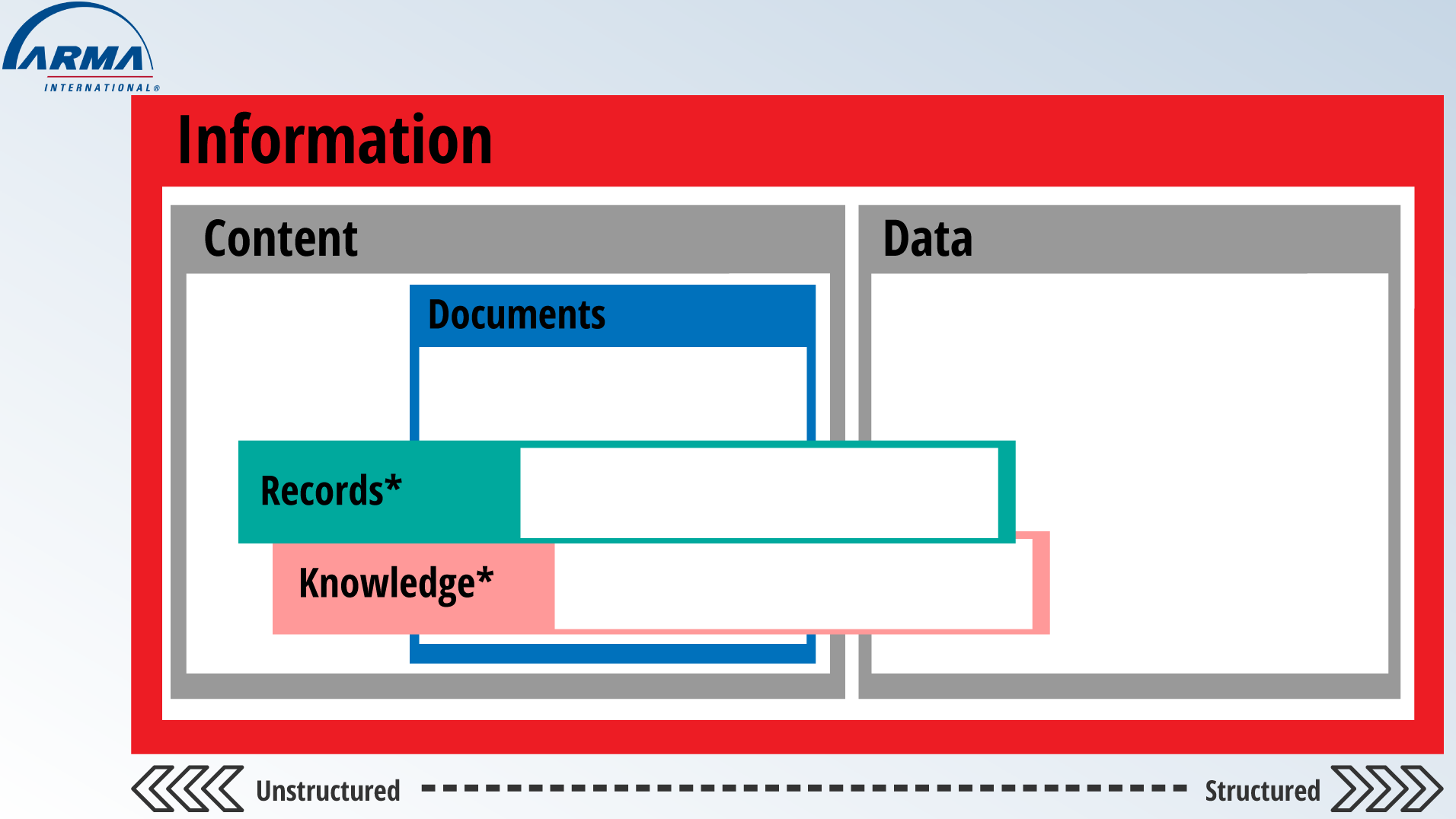
Fig. A. ARMA’s visual representation of the distinction among information and data, as well as other terms.
ARMA’s definition of information and data seems to indicate that data is structured, and content is unstructured. However, DAMA professionals and other data experts likely take issue with the simple statement that “Data is structured.” (7) Data experts describe data, and not just information, on a continuum from structured to unstructured (8), and so ARMA’s definition is not yet the final answer.
The second edition of DAMA’s Data Management Book of Knowledge (DMBOK) does not draw distinctions between data and information, but rather suggests that both can be managed together. The thesis of this article agrees with the DMBOK’s view and suggests further that the distinct differences between data and information do not need to be understood in order to govern data and information. In other words, rather than trying to find agreement through clarifying and defining exactly what data and information are, the data and information communities can unify around the goals of data governance and information governance.
What is Data Governance? What is Information Governance?
While there may be an expectation that the definitions of the words data and information would be simple, there is likely no such expectation for the definitions of the concepts of data governance and information governance.
A selected list of definitions of data governance, from both official organizations and less formal contributors, include:
- The exercise of authority and control (planning, monitoring, and enforcement) over the management of data assets. (9)
- A system of decision rights and accountabilities for information-related processes, executed according to agreed-upon models which describe who can take what actions with what information, and when, under what circumstances, using what methods. (10)
- A framework for accountability for the management of data and related resources, including data ownership, quality, architecture, tooling, access, and security. (11)
- The overall administration of the availability, integrity, security, and usability of the data available to an organization. (12)
- A mix of processes that collectively seek for the integrity, security, and availability of data. (13)
Likewise, a selected list of definitions of information governance, from both official organizations and less formal contributors, include:
- The overarching and coordinating strategy for all organizational information. It establishes the authorities, supports, processes, capabilities, structures, and infrastructure to enable information to be a useful asset and reduced liability to an organization, based on that organization’s specific business requirements and risk tolerance. (14)
- The activities and technologies that organizations employ to maximize the value of their information while minimizing associated risks and costs. (15)
- A framework for accountability to ensure appropriate behaviour and regulatory compliance in the creation, storage, use, sharing, protection, archiving, and deletion of information. (16)
- The policies, procedures, and multi-disciplinary arrangements to manage an organization’s information for its immediate and future needs. These include regulatory, legal, risk, environmental, and operational requirements. Information Governance attempts to minimize the risks and costs of storing and using information, while maximizing its value. (17)
- A strategic process that mitigates any business risk, storage costs, and makes sure that all the needed compliances are being adhered to. (18)
Based on a single reading of these definitions, a clear distinction is not achieved. Finding themes within the paragraphs of information is a lot to process. However, using a simple data visualization technique can provide an analysis. Figures B, C, and D were created by focusing on the individual words in the sentences, removing the meaningless words like the, over, of, as well as the words data, information, governance, and organization—assuming that these are a necessary part of the definition of data or information governance for an organization—and adjusting suffixes so that similar concepts matched.
The word clouds in these figures create a different form of information: different sized words, instead of different ordered words in a sentence. In a single image, Fig. B represents the content of the five definitions of data governance. These words can give a sense of the concept of data governance, at a very high level. While the words would differ slightly based on different definitions, there are some themes worth considering: ensuring security and availability of an organization’s data, and that there is integrity and accountability in processes and decisions, guided by management.
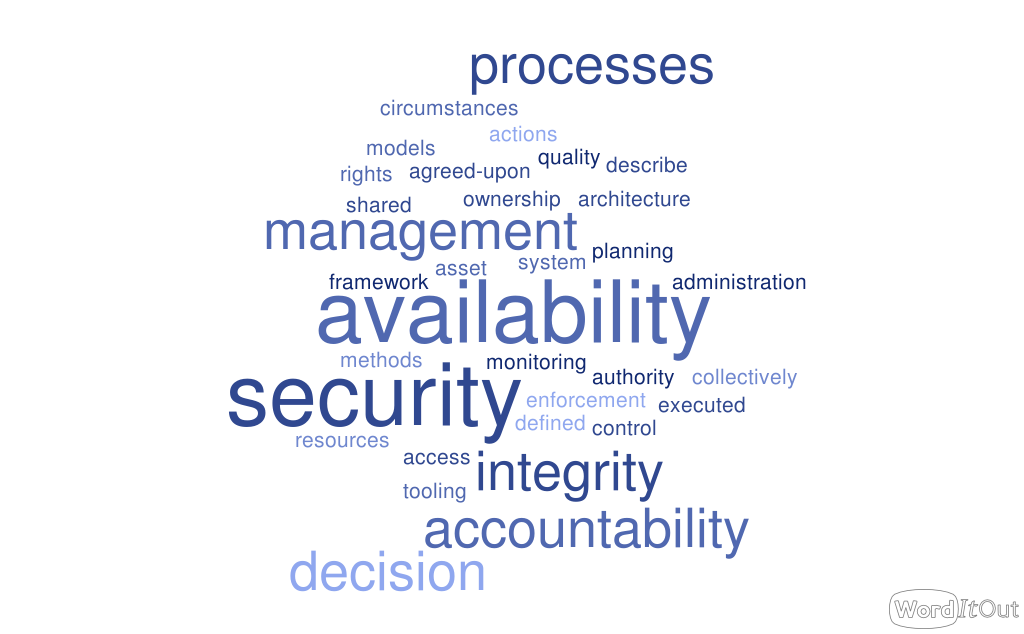



Fig. B. Word cloud based on five definitions of data governance. This image is available at https://worditout.com/word-cloud/4947457.
The same process for the five definitions of information governance resulted in the image in Fig. C. The definitions of information governance mentioned risk most often, followed closely by costs and storage. Also key to the definition are: processes, compliance, regulatory issues, value, strategy, and requirements.
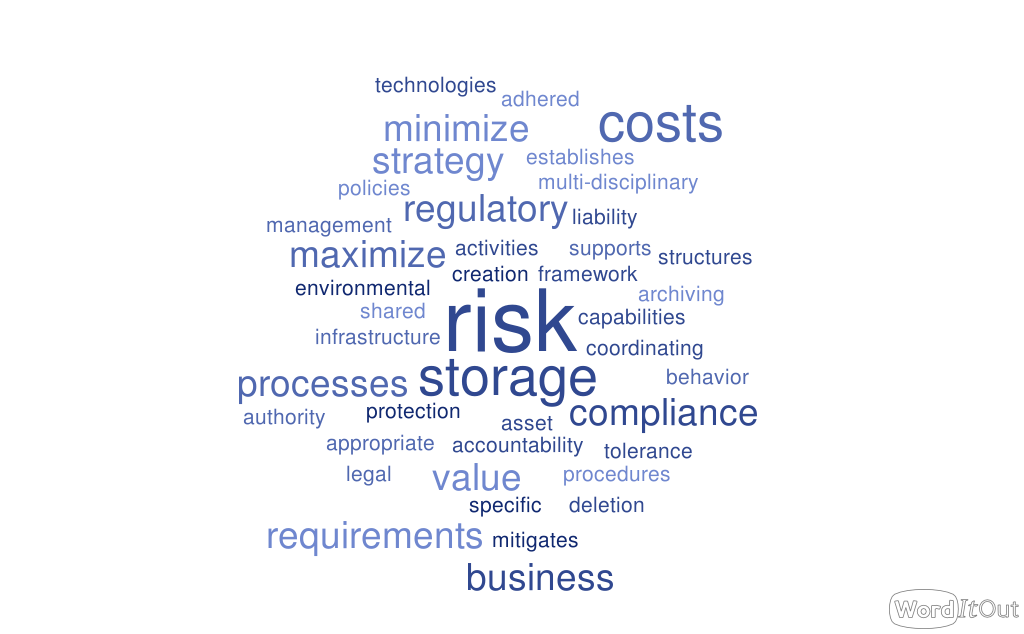



Fig. C. Word cloud based on five definitions of information governance. This image is available at https://worditout.com/word-cloud/4947477.
Finally, all ten definitions were combined to a single list, resulting in Fig. D, which may be interpreted as representing the definition of combined data and information governance. While information governance’s emphasis on risk remains significant, processes appear as the top linking factor among the definitions. Costs and storage from information governance, as well as availability, security, management, and accountability from data governance remain prominent. Some words have become more prominent in the combined version that didn’t draw attention before, such as framework, authority, asset, and shared.
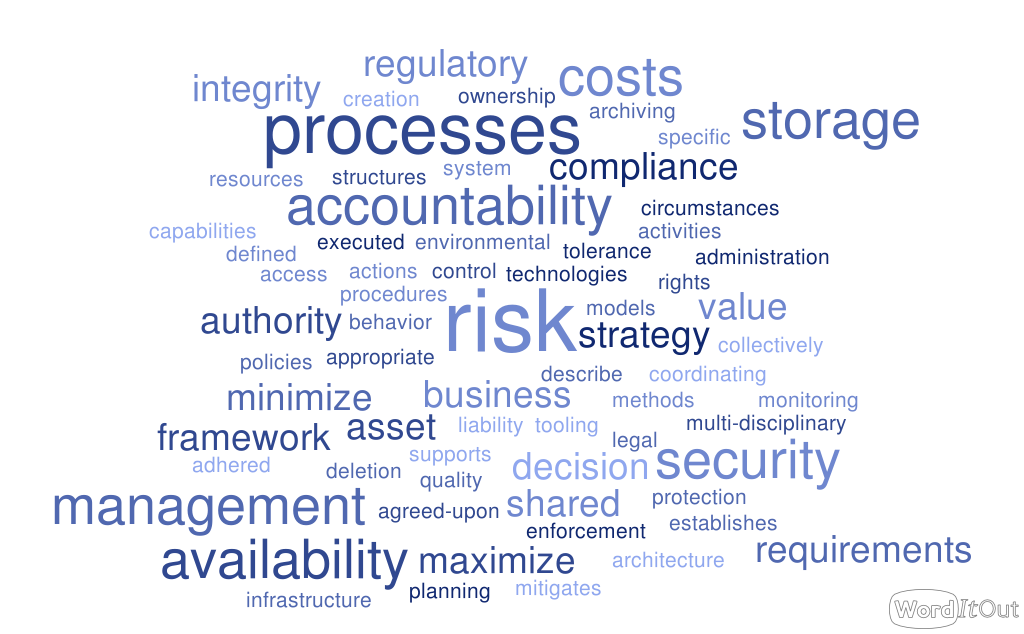



Fig. D. Word cloud based on five definitions of data governance and five definitions of information governance. This image is available at https://worditout.com/word-cloud/4947480.
While this is not a perfect nor thorough analysis, it still provides food for thought. Perhaps instead of trying to continue to clarify how data governance and information governance are different, collective efforts could move forward seeking similarities. Data governance proponents and information governance proponents could work together to ensure that data and information are secure, available, compliant, and managed as assets. Organizations like ARMA and DAMA can acknowledge and embrace the common themes and be willing to leverage the strengths of each organization and set of professionals. In other words, rather than trying to find agreement through clarifying and defining exactly what data governance and information governance are, the data and information communities can unify around the goals of data and information governance.
What is Data and Information Governance?
The above sections have shown that definitions are difficult for multiple groups to agree on, and the definition of data and information governance is no different. What follows is not a definitive description but rather one example of what an organization’s combined data and information governance committee structure might look like.
Based on materials in a Johns Hopkins University’s GovEx Academy course (19) and knowledge of a municipal government organizational structure, six roles were identified for a theoretical Data and Information Governance Committee.
- Executive or Policy Leader. This role is for foundational decision-makers who argue for, support, and/or amend information and data governance policies. There is flexibility in who exactly fills this role, but the key is to have at least one committee member at the upper most levels of the organization who will support the information and data governance committee. It is crucial that a person filling this role is passionate about the development and ongoing sustainability of a data and information governance structure because he or she will set the tone for culture and change around this topic. The role can be filled by a data expert or an information expert.
- Information & Data Leaders. This role can be filled by multiple members so that the knowledge and understanding of data professionals and information professionals are represented. These leaders should have deep understanding of the respective data and information concerns and priorities across the organization. As well, these information and data leaders need to be strong managers and clear communicators with the ability to translate data and information concepts into action.
- Stewards & Owners. Stewards and owners can exist at many levels of the organization, including the executive level, the business level, or the technical level, and particular membership will depend on the data and information held by the organization. If there are numerous potential candidates, a rotating membership could be considered. Owners have authority over the data and information. Stewards manage data and information assets on behalf of others and in the best interests of the organization.
- Information Technology (IT) Liaison. The IT department is integral to the information and data governance process. Thus, the liaison is a key role to bridge any gap between the needs of the information and data governance committee and IT through a very close working relationship, especially on issues such as information and data security. Key skills for this role include thorough understanding of data analysis, data cleaning, data mining, as well as the business and technical requirements for solutions such as enterprise content management systems. The person needs the ability to translate information and governance policies to IT implementation and vice versa.
- Communicator. Communicating with the larger organization or the public about information and data governance is crucial in an increasingly digital world. As we continue to think critically and ethically about use of data and information, communication on these topics is essential and this role is a key member of the governance committee. Any person filling this role needs to maintain a level of comfort speaking about current procedures, and be open to dialogue with clients, consumers, and residents.
- Legal & Privacy. An information and data governance program should actively build into its structure partnerships with the legal department and the privacy office. People in legal and privacy roles have access to regulations about data and information privacy and protection, and the legal team can also ensure that data and information acquired under contracts are managed in compliance with such contracts.
These six roles are one example of a committee structure that considers both information governance and data governance concepts, representing overlaps between data and information needs. Each organization will need to build the combined structure that makes most sense for their situation. For example, the Canadian Institute for Health Information publicly shares their Data and Information Governance Committee Terms of Reference, including a list of members, where the purpose of the committee is:
“to drive the data and information governance agenda … and ensure that effective data and information governance mechanisms (policies, processes, systems and practices) are in place within the organization across the data-information life cycle.” (20)
And Finally, Why Does it Matter?
Exploring definitions and comparisons of data, information, data governance, and information governance provides no end of thought-provoking materials. While some argue that there is a difference between data governance and information governance, this article argues that what differences there may be should not prevent us from identifying similarities and seeking common ground.
Both data governance and information governance aim to guide processes, establish frameworks, determine authority, protect assets, and share data and information. This guidance may be envisioned at a high level like the funnel in Fig. E, which represents a version of the conceptual relationship between data, information, knowledge, and wisdom.
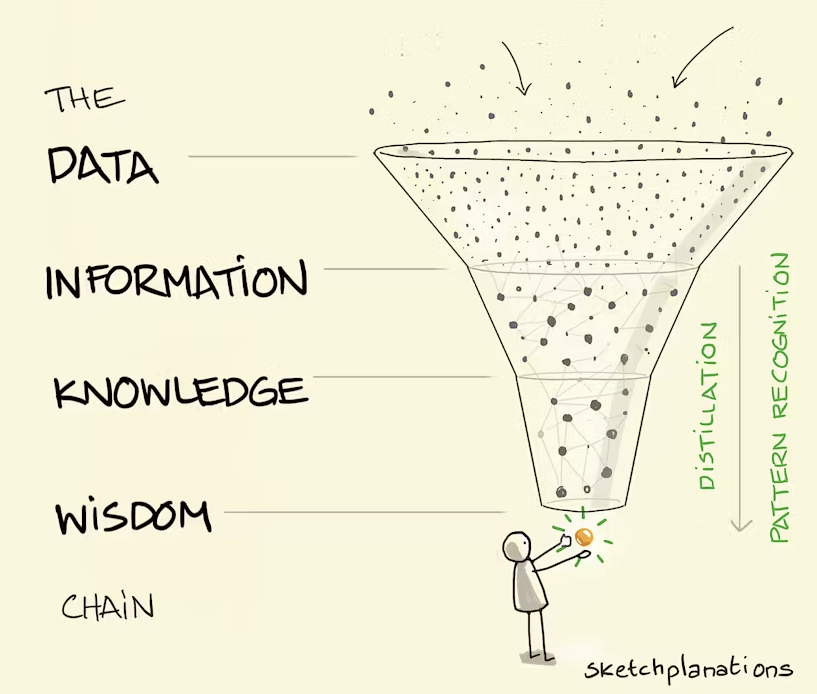



Fig. E. The DIKW chain/pyramid/hierarchy by Sketchplanations (21)
The answer to the question “Why does it matter?” may be represented by the gold nugget of wisdom shown in the figure. Determining the content of that gold nugget is the responsibility of organizational leaders. They have to sift and have to decide, based on purpose and goals, regulations, and strategy – what is important? What knowledge and wisdom are they seeking? All along the way, data and information governance, with all of the associated data and information management practices, are essential to facilitate the processes that distil the data and information down to those pieces that are important: those that lead to knowledge and wisdom.
So, if a level of uncertainty can be accepted regarding the line between data and information, and if common themes between data governance and information governance can be prioritized, then data and information professionals can help their organizations focus on this bigger picture.
Bibliography
“ARMA.” ARMA. Accessed September 30, 2021. https://www.arma.org/.
Bhatt, Vivek. “Data Governance or Information Governance?” Infotechtion. August 10, 2020. https://www.infotechtion.com/post/data-governance-or-information-governance.
“Body of Knowledge.” DAMA. Accessed September 30, 2021. https://www.dama.org/cpages/body-of-knowledge.
“Data and Information Governance Committee Terms of Reference.” Canadian Institute for Health Information. Accessed September 30, 2021. https://www.cihi.ca/en/data-and-information-governance-committee-terms-of-reference.
“Content or Data or Document or Information or Knowledge or Record?” ARMA. Accessed September 30, 2021. https://www.arma.org/page/Information.
Curtis, Brian. “Data Governance vs. Information Governance: Understanding the Two.” YourTechDiet. Accessed September 30, 2021. https://www.yourtechdiet.com/blogs/data-governance-vs-information-governance/.
“DAMA.” DAMA. Accessed September 30, 2021. https://www.dama.org/cpages/home.
“Data.” Merriam-Webster. Accessed September 30, 2021. https://www.merriam-webster.com/dictionary/data.
“Data Governance,” CIO Wiki, accessed September 30, 2021, https://cio-wiki.org/wiki/Data_Governance.
“Definition of IG.” Information Governance Initiative. Accessed September 30, 2021. https://iginitiative.com/.
“Definitions of Data Governance.” The Data Governance Institute. Accessed September 30, 2021. https://datagovernance.com/the-data-governance-basics/definitions-of-data-governance/.
Foote, Keith D. “Data Governance and Information Governance: Contemporary Solutions.” Dataversity. September 13, 2016. https://www.dataversity.net/data-governance-information-governance-contemporary-solutions/.
“Information.” Merriam-Webster. Accessed September 30, 2021. https://www.merriam-webster.com/dictionary/information.
“Information Governance.” ARMA. Accessed September 30, 2021. https://www.arma.org/page/Information_Governance.
“Structured vs. Unstructured Data: A Complete Guide.” Talend. Accessed September 30, 2021. https://www.talend.com/resources/structured-vs-unstructured-data/.
About the Author
Jennifer Bodnarchuk is the Senior Data Scientist for the City of Winnipeg. She holds a PhD in Psychology and an MSc in Data Science. She has over 20 years’ experience using data to inform decisions and is a founding member and current president of an aspiring DAMA Chapter in Winnipeg.
Endnotes
1 “Data,” Merriam-Webster, accessed September 30, 2021, https://www.merriam-webster.com/dictionary/data.
2 “Information,” Merriam-Webster, accessed September 30, 2021, https://www.merriam-webster.com/dictionary/information.
3 “ARMA,” ARMA, accessed September 30, 2021, https://www.arma.org/.
4 “DAMA,” DAMA, accessed September 30, 2021, https://www.dama.org/cpages/home.
5 “Content or Data or Document or Information or Knowledge or Record?,” ARMA, accessed September 30, 2021, https://www.arma.org/page/Information.
6 “Content or Data or Document or Information or Knowledge or Record?,” ARMA, accessed September 30, 2021, https://www.arma.org/page/Information.
7 “Structured vs. Unstructured Data: A Complete Guide,” Talend, accessed September 30, 2021, https://www.talend.com/resources/structured-vs-unstructured-data/.
8 “Body of Knowledge,” DAMA, accessed September 30, 2021, https://www.dama.org/cpages/body-of-knowledge.
9 “Data Governance,” CIO Wiki, accessed September 30, 2021, https://cio-wiki.org/wiki/Data_Governance.
10 “Definitions of Data Governance,” The Data Governance Institute, accessed September 30, 2021, https://datagovernance.com/the-data-governance-basics/definitions-of-data-governance/.
11 Vivek Bhatt, “Data Governance or Information Governance?,” Infotechtion, August 10, 2020, https://www.infotechtion.com/post/data-governance-or-information-governance.
12 Keith D. Foote, “Data Governance and Information Governance: Contemporary Solutions,” Dataversity, September 13, 2016, https://www.dataversity.net/data-governance-information-governance-contemporary-solutions/.
13 Brian Curtis, “Data Governance vs. Information Governance: Understanding the Two,” YourTechDiet, accessed September 30, 2021, https://www.yourtechdiet.com/blogs/data-governance-vs-information-governance/.
14 “Information Governance,” ARMA, accessed September 30, 2021, https://www.arma.org/page/Information_Governance.
15 “Definition of IG,” Information Governance Initiative, accessed September 30, 2021, https://iginitiative.com/.
16 Vivek Bhatt, “Data Governance or Information Governance?,” Infotechtion, August 10, 2020, https://www.infotechtion.com/post/data-governance-or-information-governance.
17 Keith D. Foote, “Data Governance and Information Governance: Contemporary Solutions,” Dataversity, September 13, 2016, https://www.dataversity.net/data-governance-information-governance-contemporary-solutions/.
18 Brian Curtis, “Data Governance vs. Information Governance: Understanding the Two,” YourTechDiet, accessed September 30, 2021, https://www.yourtechdiet.com/blogs/data-governance-vs-information-governance/.
19 https://govexacademy.jhu.edu/courses/
20 “Data and Information Governance Committee Terms of Reference.” Canadian Institute for Health Information. Accessed September 30, 2021. https://www.cihi.ca/en/data-and-information-governance-committee-terms-of-reference.
21 https://twitter.com/sketchplanator/status/1353363750989029378
